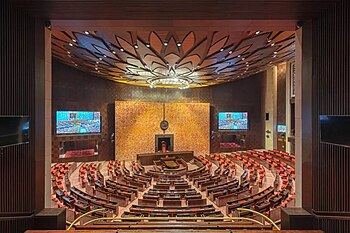
Back مجلس الشيوخ الهندي Arabic ৰাজ্যসভা AS Rajya Sabha AST Rajya Sabha AZ Радж’я Сабха BE Раджа Сабха Bulgarian राज्यसभा BH রাজ্যসভা Bengali/Bangla Sněmovna států Czech Rajya Sabha CY
Rajya Sabha | |
|---|---|
 | |
| Type | |
| Type | of the Parliament of India |
Term limits | 6 years |
| Leadership | |
Pramod Chandra Mody since 12 November 2021 | |
| Structure | |
| Seats | 245 (233 Elected + 12 Nominated) |
 | |
Political groups | Government (119) N.D.A. (119)
Opposition (121)
Unaligned (29) Vacant (5)
|
| Elections | |
| 238 members by single transferable vote by state legislatures, 12 appointed by the President | |
Last election | February 2024 |
Next election | 2025 |
| Meeting place | |
 | |
| Rajya Sabha Chamber, Sansad Bhavan, 118, Rafi Marg New Delhi, India - 110 001 | |
| Website | |
| sansad | |
| Constitution | |
| Constitution of India | |
| Rules | |
| The Rules of Procedure and Conduct of Business in the Council of States (Rajya Sabha) (English) | |
28°37′0″N 77°12′30″E / 28.61667°N 77.20833°E The Rajya Sabha, constitutionally the Council of States, is the upper house of the bicameral Parliament of India. As of 2023[update], it has a maximum membership of 250, of which 238 are elected by the legislatures of the states and union territories using single transferable votes through open ballots, while the president can appoint 12 members for their contributions to art, literature, science, and social service.[1] The total allowed capacity is 250 (238 elected, 12 appointed) according to article 80 of the Indian Constitution.[2] The current potential seating capacity of the Rajya Sabha is 245 (233 elected, 12 appointed), after the Jammu and Kashmir (Reorganisation) Act, 2019, the seats came down to 245. The maximum seats of 250 members can be filled up at the discretion and requirements of the house of Rajya Sabha.
Members sit for staggered terms lasting six years, with about a third of the 238 designates up for election every two years, in even-numbered years.[3] Unlike the Lok Sabha, the Rajya Sabha is a continuing chamber and hence not subject to dissolution. However, the Rajya Sabha, like the Lok Sabha, can be prorogued by the president.
The Rajya Sabha has equal footing in legislation with the Lok Sabha, except in the area of supply, where the latter has overriding powers. In the case of conflicting legislation, a joint sitting of the two houses can be held, where the Lok Sabha would hold a greater influence because of its larger membership. The vice president of India (currently, Jagdeep Dhankhar) is the ex-officio chairman of the Rajya Sabha, who presides over its sessions. The deputy chairman, who is elected from amongst the house's members, takes care of the day-to-day matters of the house in the absence of the chairman. The Rajya Sabha held its first sitting on 13 May 1952.[4]
The Rajya Sabha meets in the eponymous chamber in Parliament House in New Delhi. Since 18 July 2018, the Rajya Sabha has the facility for simultaneous interpretation in all the 22 scheduled languages of India.[5] The Rajya Sabha proceedings are televised live on channel Sansad TV, headquartered within the premises of Parliament.[6]
- ^ Centre, National Informatics. "Digital Sansad". Digital Sansad. Retrieved 9 January 2024.
- ^ "Rajya Sabha Introduction". rajyasabha.gov.in. Archived from the original on 15 August 2020. Retrieved 3 August 2020.
- ^ Deshmukh, Yashwant (11 June 2016). "Crucial polls today: A guide to calculus of Rajya Sabha for dummies". Firstpost. Archived from the original on 19 June 2016. Retrieved 20 June 2016.
- ^ "OUR PARLIAMENT". Indian Parliament. Archived from the original on 17 May 2011. Retrieved 11 May 2011.
- ^ "Rajya Sabha MPs can now speak in 22 Indian languages in House". The Times of India. 18 July 2018. Archived from the original on 8 October 2018. Retrieved 18 July 2018.
- ^ "SansadTV Live". SansadTV. Archived from the original on 24 June 2023. Retrieved 24 June 2023.